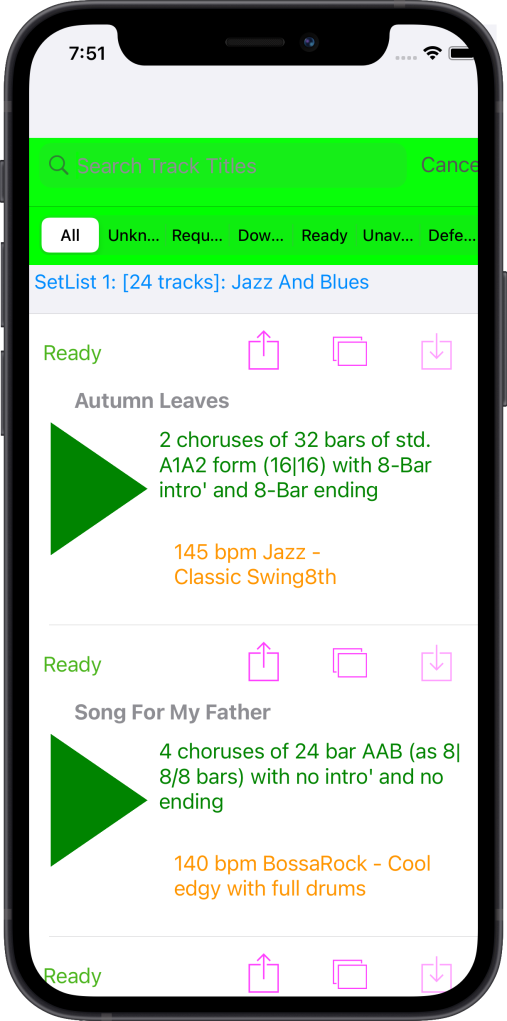
We have long believed it has to be the very first thing to get right and there’s little point playing notes at all unless they are in the desired rhythm (feel and groove). Tempo, however, is a whole other subject – there’s a lot to be said for precision and even playing tunes at markedly different tempos to internalize the piece better.
Timing is the bedrock of all music: “When a note is struck at the wrong time, it’s the wrong note”.
Getting playing in the right rhythm as soon as possible is why we have always sought out structured and inspiring rhythmic backing. This ultimately lead to “Song Rhythm Tracks“.
Rhythm and Timing
One of the most repeated terms used to, and by, musicians is that “practice makes perfect”. I’ve heard this altered to, “practice makes permanent”. i.e. if we repeat a thing over and over then we do internalize it and it becomes a facility we have “without consciously thinking about it”. This is why we can do complex coordinated movements without much conscious thought such as driving cars and even using a knife and fork. If you’ve never done these things in your life before they can be very challenging for the very first time, but once performed daily one doesn’t even recognize them as a challenge anymore. It’s as if an entirely different part of your mind is assigned to the task. So, what is important is that we are very selective about using this repetition technique and make sure it affects don’t work against us because if what we are practising is not beneficial then it will get internalized just as readily…. So, practice can make perfect; It will eventually make permanent, but that permanency can defeat you as well as help you.
Developing your own sense of timing
A key aspect of music is rhythm and timing – it’s what can make music come alive, and it’s what can kill it as well. It’s essential that we develop good rhythm and timing.
A Pulse!
If you haven’t yet developed the sense of that regular pulse that is present in most modern music – pop, folk, country, jazz – playing along to something with a pulse is of great benefit because wherever your pulse is lacking it will be clearly shown and you will automatically adjust to follow the pulse and keep the timing. Great: That’s a real win. My recommendation is to be very selective about the use of metronomes and click-tracks: There’s more to rhythm than a pulse!
But not just any pulse!
Misuse of Metronomes and click tracks Considered Harmful

Always using a click-track when you practice and when playing together in a group will likely work against developing your own human interaction on the pulse and detract from the rhythmic nuances that end up being beaten out by the demanding, oh-so-regular, ‘click’. In a similar way also, counting when you are jamming with others will be a problem: Counting the pulses within the meter, such as 1-and-a, 2-and-a, is an absolutely invaluable aid when learning a new, perhaps rhythmically challenging melody: I’ve heard it said that if you cannot count a melody or rhythmic idea out, you don’t really know it: It is great to count it out to ensure we really know it, but once you have internalized that melody, it is time to stop counting it and feel the rhythm and communicate with the others you are playing with without blocking them out by counting in your head.
The Jazz educator Steven Sedergreen in his book, “Start Playing Jazz Piano Now“, writes, “Time and feel are intuitive rather than mechanical. Reliance on mechanical means such as counting and the use of metronomes are poor substitutes for feeling it. Time emanates from within the body and move outwardly, a natural feeling that should not be restricted”. (chapter 21, para 4)
The wonderful thing about folk playing music together is the human interaction that you miss out on if you are communicating with a click-track instead of the other people you are playing with, or count out every bar in your head instead of listening to the other musicians. I’ve heard the British musician Jamie Cullum say he avoids the use of click tracks when jamming and recording because it takes away the human ebb and flow of the music when they are used. I would hate us to have missed out on the wonderful ebb and flow of his playing!
Enter Song Rhythm Tracks
What every musician needs is to always have ready a great sounding groove that fits the tune, is truly musical and is being played to the form of the song. This is the concept behind Song Rhythm Tracks. These tracks are developed from careful recordings of long-form audio (8-bars or more at a time) of exceptionally talented drummers. They are arranged around the form of your song so that the song’s form is always being communicated to the musician. What’s more the design makes it possible to arrange new tracks in as little as 15 – 30 seconds and always have your tracks ready, just a few presses away. It turns out there is never a reason not to have these tracks at hand.
Now you can always practice in the groove!

